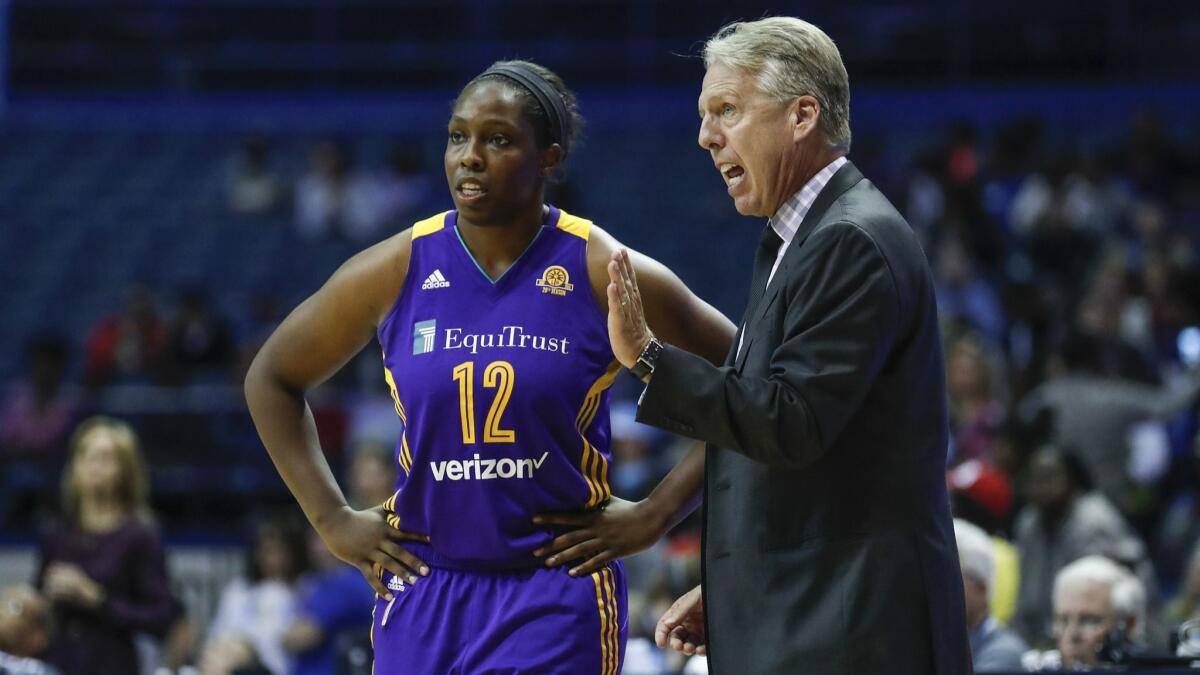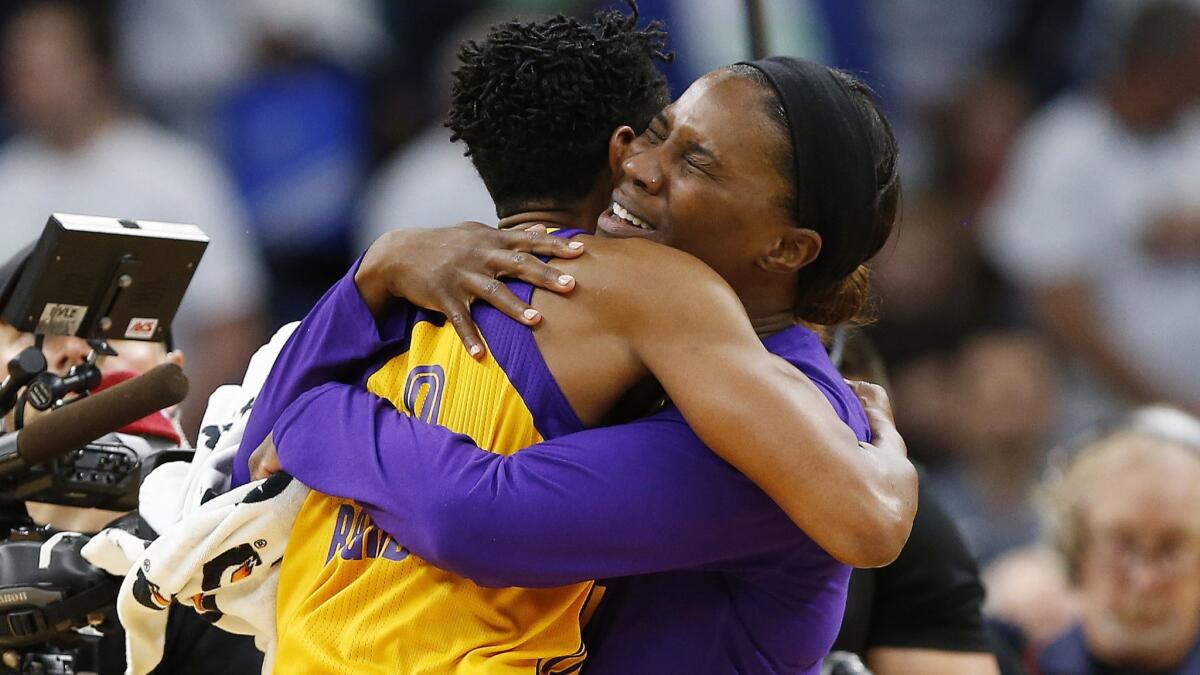Overseas obligations raise concerns for Sparks ahead of season opener
- Share via
In the wake of last season’s demoralizing loss in the deciding game of the league championship series, Los Angeles’ WNBA team began training camp late last month needing a spark.
No, literally, they needed a Spark.
Only three of their players showed up.
In what has become the WNBA’s annual rite of international passage, the rest of the regular team was busy making a living playing professional basketball overseas.
When the Sparks begin their 22nd season Sunday in Minnesota against the defending champion Lynx, some of their players will have just arrived. Some still won’t be there. Most of them will have not played together in months.
It will be an opening day without bands or bunting. It will be equally exhausting and exhilarating, a day marked by as much pain as promise. Some will show up suffering from severe jet lag. Others will be so weary they can barely walk. All of these tough, tough women will be paying the price for stepping back on to the court seemingly moments after finishing a grueling seven-month international season necessary for them to maximize their earning potential.
”It’s exhausting mentally, physically, emotionally,’’ said Ticha Penicheiro, former Sparks guard and WNBA All-Star who now represents WNBA players. “Literally you get off a plane from one super competitive league and go straight to another one. Sometimes it’s like, ‘Why am I doing this?’ ’’
Most would rather play only in the WNBA, but the WNBA pays them as much as 10 times less than some foreign teams. More than 75% of the league plays in both places, playing for virtually the entire year, and these annual spring homecomings are no parades.
“People can’t fully grasp it unless they’re in this position,’’ said the Sparks’ Chelsea Gray, who finished a full season in Turkey and was practicing at Galen Center five days later. “You’re always going, going, into full throttle. It’s a challenge.’’

Brian Agler is a two-time WNBA championship coach, and his Sparks are a three-time championship franchise, yet their training camp began on a court filled with the basketball equivalent of extras. The stand-ins suited up so the three regulars would have enough for a game. There were so many new anonymous faces that Agler sometimes struggled to remember their names.
“It’s not ideal for anybody,’’ Agler said. “We were practicing with 10 players who weren’t even going to be on our team.’’
That patchwork squad actually played two exhibition games together. A couple of more regulars returned home for a third and final exhibition. Even with the season starting, the team is not together, as Jantel Lavender and Maria Vadeeva are still overseas, which is problematic for another reason.
Vadeeva, from Russia, was the club’s first-round draft pick this spring, yet Agler has never even met her.
“It’s completely different,’’ Agler said. “It’s hard to explain.’’
It’s impossible to imagine Lakers coach Luke Walton requiring an introduction to Lonzo Ball during the regular season, but such is life in the first weeks of an WNBA schedule, where everyone is just trying to catch their breath and find their legs.
”That’s the dynamic we deal with that nobody else does,’’ Agler said. “Every year it’s like this, and there’s no solution.’’
All they can do is adjust, which Alger does when he realizes he can’t rely on standard plays that few have had time to practice. So he sometimes draws up plays on the sideline, on the spot.
Said Agler: “There is an element of playground basketball early in the season.’’
Said Gray: “You get used to a lot of non-verbal communication.’’
Agler also has to watch his players’ minutes, not because they are weary of playing for him, but because they are still dragging from their other league. Last season, Essence Carson played her first game without a practice after climbing off her international flight less than 24 hours earlier. She started, yet was so exhausted she played just seven minutes.
“Essence tried to come back and play but she was just gassed,’’ Agler said. “You ask NBA players if they would ever do something like this. It’s very difficult.’’
Agler figures the Sparks, like most WNBA teams, finally settle into their season by the middle of June. But the first-month struggles are an annual reminder of an unsettling reality.
Despite the economic and perceptual gains made by women’s sports in the United States, some of our greatest female athletes still have to leave the country to get the most out of their abilities.
“We are tough as nails, we are women with character,’’ Penicheiro said. “We have to really hustle if we want to make a career out of this.’’

The 2017 WNBA season set records for social media and merchandise. The league had its highest attendance in six years. The dramatic Finals between the Sparks and Lynx was the third-most watch Finals since the ESPN family began broadcasting the event in 2003.
In some ways, the 22-year-old operation has never been stronger. It easily remains the best, most competitive women’s basketball league in the world.
But even at its healthiest, in a crowded American sports landscape, it still can’t come close to attracting the sort of attention and revenue that can turn it into a full-time job.
“The games are amazing, better than the men, but so far we can’t draw the big crowds, we can’t get people, on average, to support the cause,’’ Penicheiro said. “That’s just where we are.’’
The WNBA has a hard salary cap with a rookie minimum salary of $50,000 and a veteran max of around $115,000. Some of those same players can make $500,000 a year playing overseas, where wealthy owners view their teams as a status symbol worth an endless investment.
The foreign pockets are so deep that star Diana Taurasi actually skipped the 2015 season with the Phoenix Mercury when her Russian team paid her $107,000 Mercury salary – on top of her $1.5 million Russian salary -- if she would spend the summer resting.
“When a player is tired from playing in two leagues, and asks me why they are doing it, I ask them, do they have a computer?’’ Penicheiro said. “I tell them log in, check your bank account, that’s why you do it.’’
So they keep doing it even though the WNBA allots $50,000 per team to supplement players who chose to stay home. It’s a losing battle, so much that the four-month WNBA schedule actually ends as the seven-month international schedule begins, because what WNBA team wants its players bolting for China in the middle of the playoffs?
It all makes for an interesting first couple of WNBA weeks, which will be even more difficult for the Sparks as they travel to Minnesota, Indiana and Connecticut before returning to Staples Center for their home opener on May 27.
They fly commercial, by the way. And they are guaranteed seats only in coach.
“They can fly first class only if they use their frequent flier miles,’’ Aglers said.
The resilient women of the WNBA may have to fight for everything else, but at least they have plenty of those.
Get more of Bill Plaschke’s work and follow him on Twitter @BillPlaschke
More to Read
Go beyond the scoreboard
Get the latest on L.A.'s teams in the daily Sports Report newsletter.
You may occasionally receive promotional content from the Los Angeles Times.











